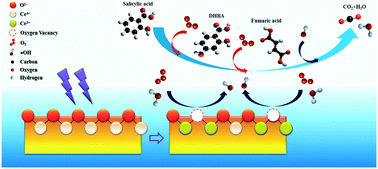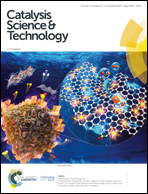Promoting surface oxygen vacancies on ceria via light pretreatment to enhance catalytic ozonation†
Abstract
Catalytic ozonation is an advanced oxidation approach capable of indiscriminately removing organic pollutants from aqueous systems. Here, for the first time we demonstrate that, on pre-treating ceria with UV light, its performance in the catalytic ozonation of salicylic acid (SA) can be enhanced three-fold relative to the untreated catalyst as well as outperforming hydrogen-reduced ceria. Light pre-treatment was found to enrich oxygen vacancy numbers on the ceria surface which yielded the improved catalytic activity. Mechanistic studies indicated the degradation of SA and the first-produced intermediate, dihydroxybenzoic acid, into short-chain organic acids proceeded via direct ozonation rather than being catalyzed by ceria. Catalytic ozonation by ceria instead contributed principally to degrading the short chain organic acids to CO2 and water. Oxygen vacancies on ceria were responsible for catalyzing ozone into hydroxyl radicals which accelerated the organic acid degradation process. The beneficial influence of light pre-treatment on ceria was preserved over five sequential catalytic ozonation cycles. The outcomes from the study illustrate that light pre-treatment is useful for intensifying the oxygen vacancy defect levels on ceria which are central to its performance in catalytic ozonation.

- This article is part of the themed collection: 2019 Catalysis Science & Technology HOT Articles


 Please wait while we load your content...
Please wait while we load your content...